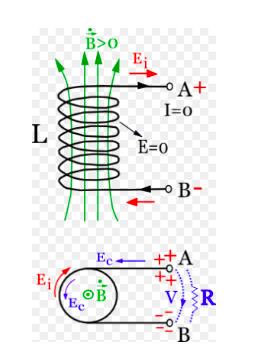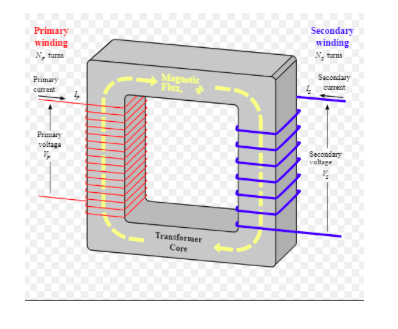
In SI, Henry is the unit of
A. Self-inductance
B. Mutual inductance
C. (A) and (B) both
D.None of the above
Answer
576.3k+ views
Hint:One Henry is the amount of inductance of a closed-circuit or coil that generates a voltage of one volt when the inducing current changes by one Ampere per second. It is the SI unit of both self and mutual inductance.
Step by step solution:
Induction is defined as the phenomenon portrayed by an electrical conductor to oppose the change of current flowing through it.
When current flows in a circuit, a magnetic field is generated around it. This magnetic field is dependent on the current flow of the circuit ; with the change in current flow, the strength of the magnetic field also changes.
According to Faraday’s Law of Induction, the induced magnetic field has the potential of creating its voltage. A change in the strength of it, in turn, produces an electromotive force (voltage). This phenomenon is stated by Lenz’s Law and is termed as “back electromotive force (emf)”.
We know that, change in current $ = \dfrac{{di}}{{dt}}(A/s)$.
Where $di$ the change in current and is expressed in Amperes $(A)$ and $dt$ is the time taken for this current to change in time and expressed in seconds $(s)$.
Therefore, the voltage induced in the coil ${V_L} = - L\dfrac{{di}}{{dt}}(V)$.
Where $L$ is the inductance as a result of this change in current and is expressed in Henry $(H)$ and ${V_L}$ is the voltage induced and is expressed in Volts $(V)$.
The negative sign is due to the opposing nature of the induced voltage to the change in current in the coil or circuit per unit time.
Rearranging the equation we get,
\[L = \dfrac{{{V_L}}}{{(\dfrac{{di}}{{dt}})}} = \dfrac{{1 volt}}{{1A/s}} = 1 Henry\]
Thus, Induction can also be defined as the ratio of change in induced voltage of the circuit or coil to change in current in it.
Self-induction is defined as the phenomenon of emf induction in a circuit or coil by itself and in mutual induction a changing current in one coil induces emf in the other.
Mathematically,
Self-inductance $ = L = N\dfrac{\Phi }{I}$
Where $N$ is the number of turns and is unit-less, $\Phi $ is the magnetic flux and is expressed in Weber $(Wb)$ and $I$ is the current flowing through the circuit or coil and is measured in Amperes $(A)$.

And, mutual inductance \[ = M = \dfrac{{{\mu _o}{\mu _r}{N_1}{N_2}A}}{l}\]
Where \[{\mu _o}\] is the permeability of free space and is usually of the value $4\pi {10^{ - 7}}$, ${\mu _r}$ is the relative permeability of the soft iron core and is unit-less, $N$ is the number of coil turns, $A$ is the cross-sectional area and is expressed in ${m^2}$ and $l$ is the coil length and is expressed in meters $(m)$.

But, no matter what the method of emf induction is, the unit of inductance for itself.
Conclusively, in the SI unit, Henry is the unit of self-inductance and mutual inductance both (option c).
Note: ${V_L}$ is always negative as it is the opposing voltage to the current flow.
Also, as inductance is a resisting force to the current flow, the larger its value the lower the rate of current flowing in the circuit or coil.
Additional information:Another definition of Henry is Webers per Ampere, that is $1H = 1Wb/A$.
Step by step solution:
Induction is defined as the phenomenon portrayed by an electrical conductor to oppose the change of current flowing through it.
When current flows in a circuit, a magnetic field is generated around it. This magnetic field is dependent on the current flow of the circuit ; with the change in current flow, the strength of the magnetic field also changes.
According to Faraday’s Law of Induction, the induced magnetic field has the potential of creating its voltage. A change in the strength of it, in turn, produces an electromotive force (voltage). This phenomenon is stated by Lenz’s Law and is termed as “back electromotive force (emf)”.
We know that, change in current $ = \dfrac{{di}}{{dt}}(A/s)$.
Where $di$ the change in current and is expressed in Amperes $(A)$ and $dt$ is the time taken for this current to change in time and expressed in seconds $(s)$.
Therefore, the voltage induced in the coil ${V_L} = - L\dfrac{{di}}{{dt}}(V)$.
Where $L$ is the inductance as a result of this change in current and is expressed in Henry $(H)$ and ${V_L}$ is the voltage induced and is expressed in Volts $(V)$.
The negative sign is due to the opposing nature of the induced voltage to the change in current in the coil or circuit per unit time.
Rearranging the equation we get,
\[L = \dfrac{{{V_L}}}{{(\dfrac{{di}}{{dt}})}} = \dfrac{{1 volt}}{{1A/s}} = 1 Henry\]
Thus, Induction can also be defined as the ratio of change in induced voltage of the circuit or coil to change in current in it.
Self-induction is defined as the phenomenon of emf induction in a circuit or coil by itself and in mutual induction a changing current in one coil induces emf in the other.
Mathematically,
Self-inductance $ = L = N\dfrac{\Phi }{I}$
Where $N$ is the number of turns and is unit-less, $\Phi $ is the magnetic flux and is expressed in Weber $(Wb)$ and $I$ is the current flowing through the circuit or coil and is measured in Amperes $(A)$.

And, mutual inductance \[ = M = \dfrac{{{\mu _o}{\mu _r}{N_1}{N_2}A}}{l}\]
Where \[{\mu _o}\] is the permeability of free space and is usually of the value $4\pi {10^{ - 7}}$, ${\mu _r}$ is the relative permeability of the soft iron core and is unit-less, $N$ is the number of coil turns, $A$ is the cross-sectional area and is expressed in ${m^2}$ and $l$ is the coil length and is expressed in meters $(m)$.

But, no matter what the method of emf induction is, the unit of inductance for itself.
Conclusively, in the SI unit, Henry is the unit of self-inductance and mutual inductance both (option c).
Note: ${V_L}$ is always negative as it is the opposing voltage to the current flow.
Also, as inductance is a resisting force to the current flow, the larger its value the lower the rate of current flowing in the circuit or coil.
Additional information:Another definition of Henry is Webers per Ampere, that is $1H = 1Wb/A$.
Recently Updated Pages
The number of solutions in x in 02pi for which sqrt class 12 maths CBSE

Write any two methods of preparation of phenol Give class 12 chemistry CBSE

Differentiate between action potential and resting class 12 biology CBSE

Two plane mirrors arranged at right angles to each class 12 physics CBSE

Which of the following molecules is are chiral A I class 12 chemistry CBSE

Name different types of neurons and give one function class 12 biology CBSE

Trending doubts
Which are the Top 10 Largest Countries of the World?

What are the major means of transport Explain each class 12 social science CBSE

Draw a labelled sketch of the human eye class 12 physics CBSE

Draw the diagram showing the germination of pollen class 12 biology CBSE

Differentiate between insitu conservation and exsitu class 12 biology CBSE

The computer jargonwwww stands for Aworld wide web class 12 physics CBSE




